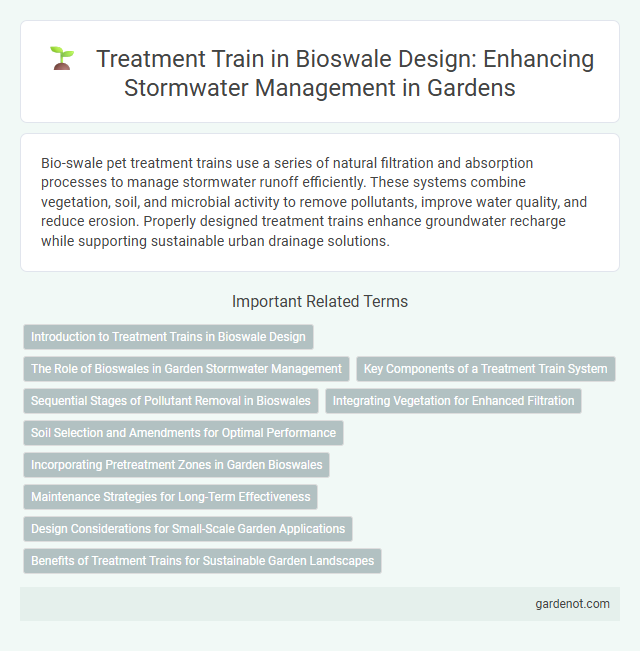Bio-swale pet treatment trains use a series of natural filtration and absorption processes to manage stormwater runoff efficiently. These systems combine vegetation, soil, and microbial activity to remove pollutants, improve water quality, and reduce erosion. Properly designed treatment trains enhance groundwater recharge while supporting sustainable urban drainage solutions.
Introduction to Treatment Trains in Bioswale Design
Treatment trains in bioswale design integrate multiple stormwater management practices to enhance pollutant removal and water quality improvement. These sequential processes typically combine sedimentation, filtration, infiltration, and biological uptake within the bioswale system, effectively reducing runoff volume and contaminant loads. By optimizing treatment trains, bioswales maximize pollutant retention and support sustainable urban drainage infrastructures.
The Role of Bioswales in Garden Stormwater Management
Bioswales function as a critical component in garden stormwater management by filtering pollutants and facilitating infiltration through vegetation and engineered soil layers. Acting as a natural treatment train, bioswales reduce runoff volume and improve water quality before water reaches larger drainage systems or groundwater reserves. Their strategic placement within gardens enhances sediment capture, nutrient absorption, and erosion control, promoting sustainable urban water cycles.
Key Components of a Treatment Train System
Key components of a treatment train system for bio-swales include sedimentation basins, vegetated swales, and infiltration zones designed to sequentially remove pollutants from stormwater runoff. Sedimentation basins capture large particulates, vegetated swales utilize plant roots and soil microbes to filter nutrients and contaminants, and infiltration zones promote groundwater recharge by allowing clean water to percolate through the soil. This systematic approach enhances water quality, reduces volume, and supports sustainable urban drainage.
Sequential Stages of Pollutant Removal in Bioswales
Bioswales employ a treatment train consisting of sequential stages that optimize pollutant removal through sedimentation, filtration, and biological uptake. Initial stages capture coarse sediments and debris, while subsequent layers promote microbial degradation and nutrient absorption by vegetation. This multi-stage process enhances water quality by systematically reducing contaminants such as heavy metals, nitrogen, phosphorus, and suspended solids.
Integrating Vegetation for Enhanced Filtration
Integrating vegetation in bio-swales significantly enhances filtration by increasing pollutant uptake and promoting microbial activity within root zones. Deep-rooted native plants improve soil permeability and stabilize sediment, optimizing water retention and nutrient absorption throughout the treatment train. This vegetative layer acts as a natural filter, effectively reducing contaminants such as heavy metals, nitrogen, and suspended solids before stormwater reaches downstream ecosystems.
Soil Selection and Amendments for Optimal Performance
Soil selection and amendments play a critical role in the performance of bio-swales within treatment trains by enhancing filtration, infiltration, and pollutant removal. Ideal soils exhibit high permeability combined with adequate organic content to support microbial activity and plant health, ensuring effective nutrient breakdown and sediment capture. Incorporating amendments such as compost or biochar improves soil structure, increases moisture retention, and boosts pollutant adsorption capacity, optimizing the bio-swale's overall treatment efficiency.
Incorporating Pretreatment Zones in Garden Bioswales
Incorporating pretreatment zones in garden bioswales enhances sediment removal and reduces pollutant load before water enters the main treatment area. Pretreatment zones often consist of vegetated filter strips or forebays that slow runoff velocity and promote sedimentation, improving overall system performance. Optimizing these zones within the treatment train increases the longevity and efficiency of bioswales by preventing downstream clogging and enhancing pollutant retention.
Maintenance Strategies for Long-Term Effectiveness
Effective maintenance strategies for bio-swale treatment trains involve regular inspection to prevent sediment build-up and vegetation overgrowth, which can impede water flow and pollutant removal. Implementing scheduled removal of accumulated debris and repairing erosion or damage ensures sustained hydraulic performance and contaminant filtration. Incorporating adaptive management based on seasonal and storm event data optimizes long-term pollutant reduction and ecosystem health within the bio-swale system.
Design Considerations for Small-Scale Garden Applications
Design considerations for small-scale garden bio-swales focus on optimizing soil permeability, vegetation selection, and stormwater flow paths to enhance pollutant removal and infiltration capacity. Incorporating native plant species with deep root systems improves water uptake and soil stability while reducing maintenance needs. Proper grading and hydraulic sizing ensure effective capture and conveyance of runoff, preventing erosion and maximizing treatment efficiency in limited urban garden spaces.
Benefits of Treatment Trains for Sustainable Garden Landscapes
Treatment trains in bio-swales enhance water quality by sequentially filtering stormwater through diverse media, promoting pollutant removal and minimizing runoff contamination. These systems support sustainable garden landscapes by improving soil health, conserving water, and reducing erosion through effective sediment capture. Integrating treatment trains optimizes nutrient cycling and fosters resilient urban ecosystems, making them essential for eco-friendly landscape design.
Treatment train Infographic

 gardenot.com
gardenot.com